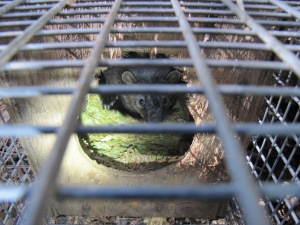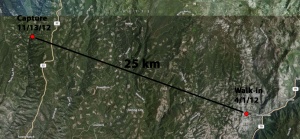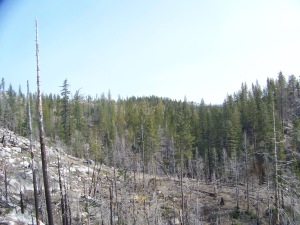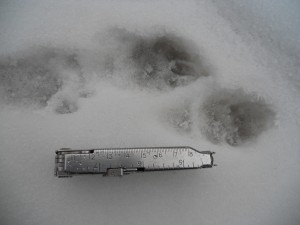We recently wrapped up our month-long fall trapping event (aka Fisher Frenzy). This is the 4th year we have conducted this large scale trapping event, and 2014 proved to be our most successful to date. Over the course of the month, we were able to capture 32 individual fishers!
We conduct this trapping effort for a variety of reasons. First and foremost, it allows us to affix radio-collars on fishers. Most of our collar’s batteries tend to last a little over a year, and thus the collars we put out in 2013 do not have very much life left. The new collars we put out should last us until next year at this time and allow us to track the fishers throughout the year. We also learn a lot by examining the fishers we do catch. We can get an idea of overall condition, age, past reproduction, parasite load, and old or new wounds. Sometimes, we even get the shock of seeing something completely unexpected, like imbedded porcupine quills!
On a more personal note, trapping is the time of year that we actually get to see fishers (as well as some of the other forest mesocarnivores) up close and personal. This is immensely enjoyable to me, as most of the year it’s rare even to get a glimpse of the fishers we are tracking on a daily basis.
As in previous years, we spent the first two weeks trapping the east side of the district before moving to the west side for another two weeks. On the east side, we totaled 36 fisher captures of 24 individuals (18Female:6Male). 11 of these were fishers that we had never captured before (6F:5M). Our success slowed down on the west side of the district, but we did manage 17 total fisher captures of 8 individuals (5F:3M). Of these, 4 were fishers who had not been caught before (3F:1M).
In total, we ran over 2,700 trap nights! We recaptured 17 fishers from previous years (14F, 3M), as well as picked up 15 fishers (9F:6M) that we had never caught before. Our overall trapping success rate for fishers was 1.9%. Besides fishers, we also capture quite a number of other animals in our traps. We managed to catch 45 spotted skunks, 32 ringtails, 15 grey foxes, 3 striped skunks, 2 raccoons, and even 1 bear cub (luckily mom didn’t seem to be around).
Every year, there are a few wise fishers that manage to evade our traps. At the end of trapping, we had 4 known on-air fishers that we did not catch. Adding those animals to the number of fishers we did catch gives us a “minimum known alive” population size of 36 individuals. Of course, it’s likely we are not capturing all the fishers that are out on the landscape (we are also not able to trap every area we would like to because it’s not logistically feasible).
In order to run trapping at such a large scale (~100 traps open per night), we require a large amount of personnel, time, and effort. This year, we had over 25 people come out to help us with our daily trap checks and examinations! All of the project cooperators (California Fish and Wildlife, North Carolina State University, Sierra Pacific Industries, US Fish and Wildlife Service, and Wildlife Conservation Society), made large contributions to help pull this event off. A HUGE thank you to everyone who gave their time and effort to help make this year’s trapping a success!
Here are a few pictures from this year:














